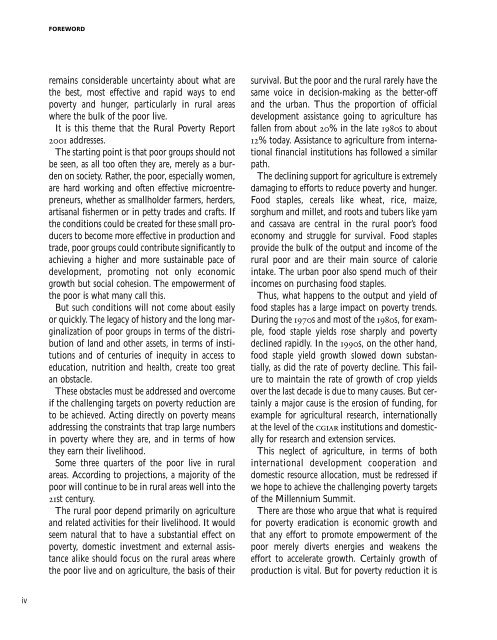THE CHALLENGE OF ENDING RURAL POVERTY - IFAD
THE CHALLENGE OF ENDING RURAL POVERTY - IFAD
THE CHALLENGE OF ENDING RURAL POVERTY - IFAD
You also want an ePaper? Increase the reach of your titles
YUMPU automatically turns print PDFs into web optimized ePapers that Google loves.
FOREWORD<br />
remains considerable uncertainty about what are<br />
the best, most effective and rapid ways to end<br />
poverty and hunger, particularly in rural areas<br />
where the bulk of the poor live.<br />
It is this theme that the Rural Poverty Report<br />
2001 addresses.<br />
The starting point is that poor groups should not<br />
be seen, as all too often they are, merely as a burden<br />
on society. Rather, the poor, especially women,<br />
are hard working and often effective microentrepreneurs,<br />
whether as smallholder farmers, herders,<br />
artisanal fishermen or in petty trades and crafts. If<br />
the conditions could be created for these small producers<br />
to become more effective in production and<br />
trade, poor groups could contribute significantly to<br />
achieving a higher and more sustainable pace of<br />
development, promoting not only economic<br />
growth but social cohesion. The empowerment of<br />
the poor is what many call this.<br />
But such conditions will not come about easily<br />
or quickly. The legacy of history and the long marginalization<br />
of poor groups in terms of the distribution<br />
of land and other assets, in terms of institutions<br />
and of centuries of inequity in access to<br />
education, nutrition and health, create too great<br />
an obstacle.<br />
These obstacles must be addressed and overcome<br />
if the challenging targets on poverty reduction are<br />
to be achieved. Acting directly on poverty means<br />
addressing the constraints that trap large numbers<br />
in poverty where they are, and in terms of how<br />
they earn their livelihood.<br />
Some three quarters of the poor live in rural<br />
areas. According to projections, a majority of the<br />
poor will continue to be in rural areas well into the<br />
21st century.<br />
The rural poor depend primarily on agriculture<br />
and related activities for their livelihood. It would<br />
seem natural that to have a substantial effect on<br />
poverty, domestic investment and external assistance<br />
alike should focus on the rural areas where<br />
the poor live and on agriculture, the basis of their<br />
survival. But the poor and the rural rarely have the<br />
same voice in decision-making as the better-off<br />
and the urban. Thus the proportion of official<br />
development assistance going to agriculture has<br />
fallen from about 20% in the late 1980s to about<br />
12% today. Assistance to agriculture from international<br />
financial institutions has followed a similar<br />
path.<br />
The declining support for agriculture is extremely<br />
damaging to efforts to reduce poverty and hunger.<br />
Food staples, cereals like wheat, rice, maize,<br />
sorghum and millet, and roots and tubers like yam<br />
and cassava are central in the rural poor’s food<br />
economy and struggle for survival. Food staples<br />
provide the bulk of the output and income of the<br />
rural poor and are their main source of calorie<br />
intake. The urban poor also spend much of their<br />
incomes on purchasing food staples.<br />
Thus, what happens to the output and yield of<br />
food staples has a large impact on poverty trends.<br />
During the 1970s and most of the 1980s, for example,<br />
food staple yields rose sharply and poverty<br />
declined rapidly. In the 1990s, on the other hand,<br />
food staple yield growth slowed down substantially,<br />
as did the rate of poverty decline. This failure<br />
to maintain the rate of growth of crop yields<br />
over the last decade is due to many causes. But certainly<br />
a major cause is the erosion of funding, for<br />
example for agricultural research, internationally<br />
at the level of the CGIAR institutions and domestically<br />
for research and extension services.<br />
This neglect of agriculture, in terms of both<br />
international development cooperation and<br />
domestic resource allocation, must be redressed if<br />
we hope to achieve the challenging poverty targets<br />
of the Millennium Summit.<br />
There are those who argue that what is required<br />
for poverty eradication is economic growth and<br />
that any effort to promote empowerment of the<br />
poor merely diverts energies and weakens the<br />
effort to accelerate growth. Certainly growth of<br />
production is vital. But for poverty reduction it is<br />
iv

















